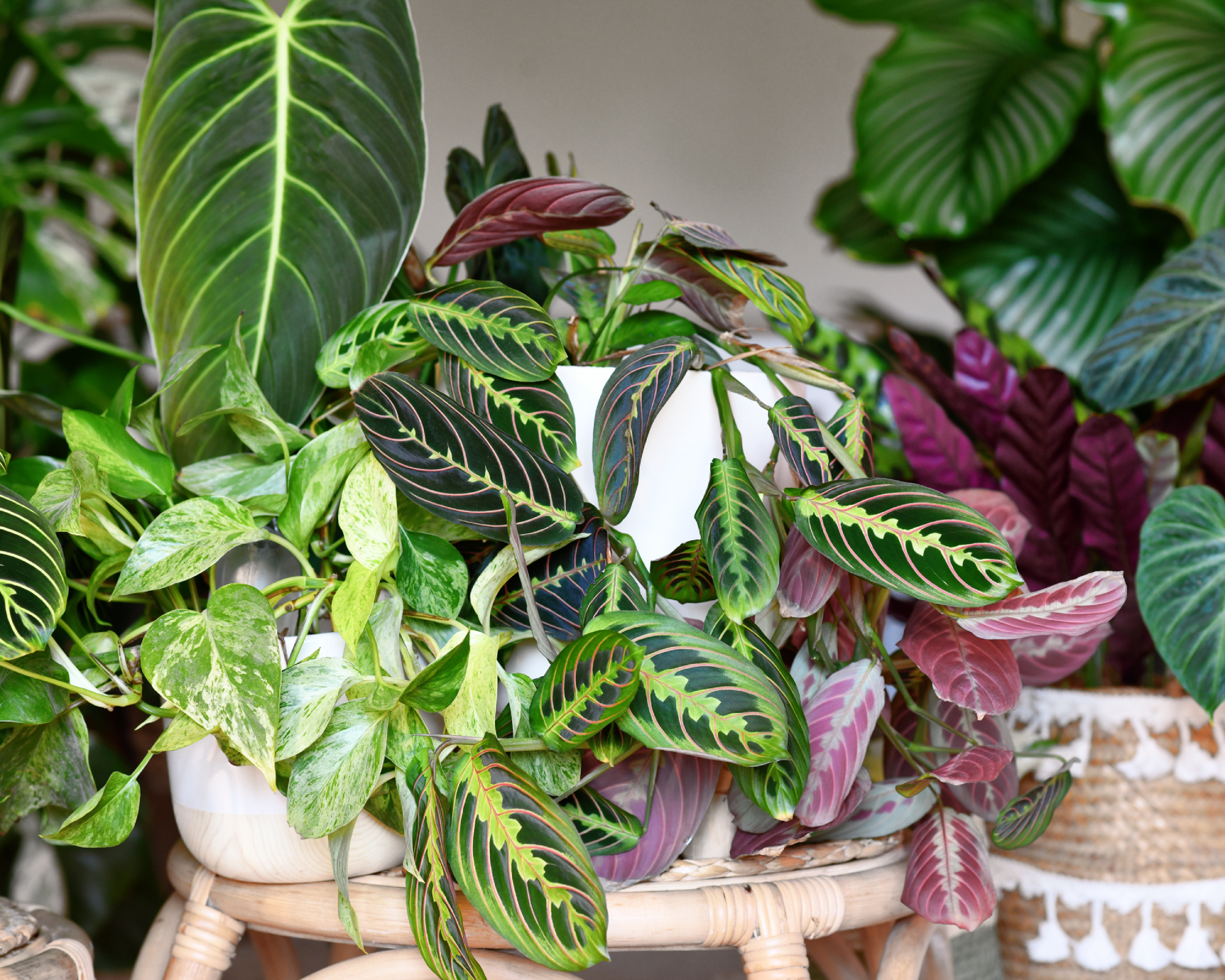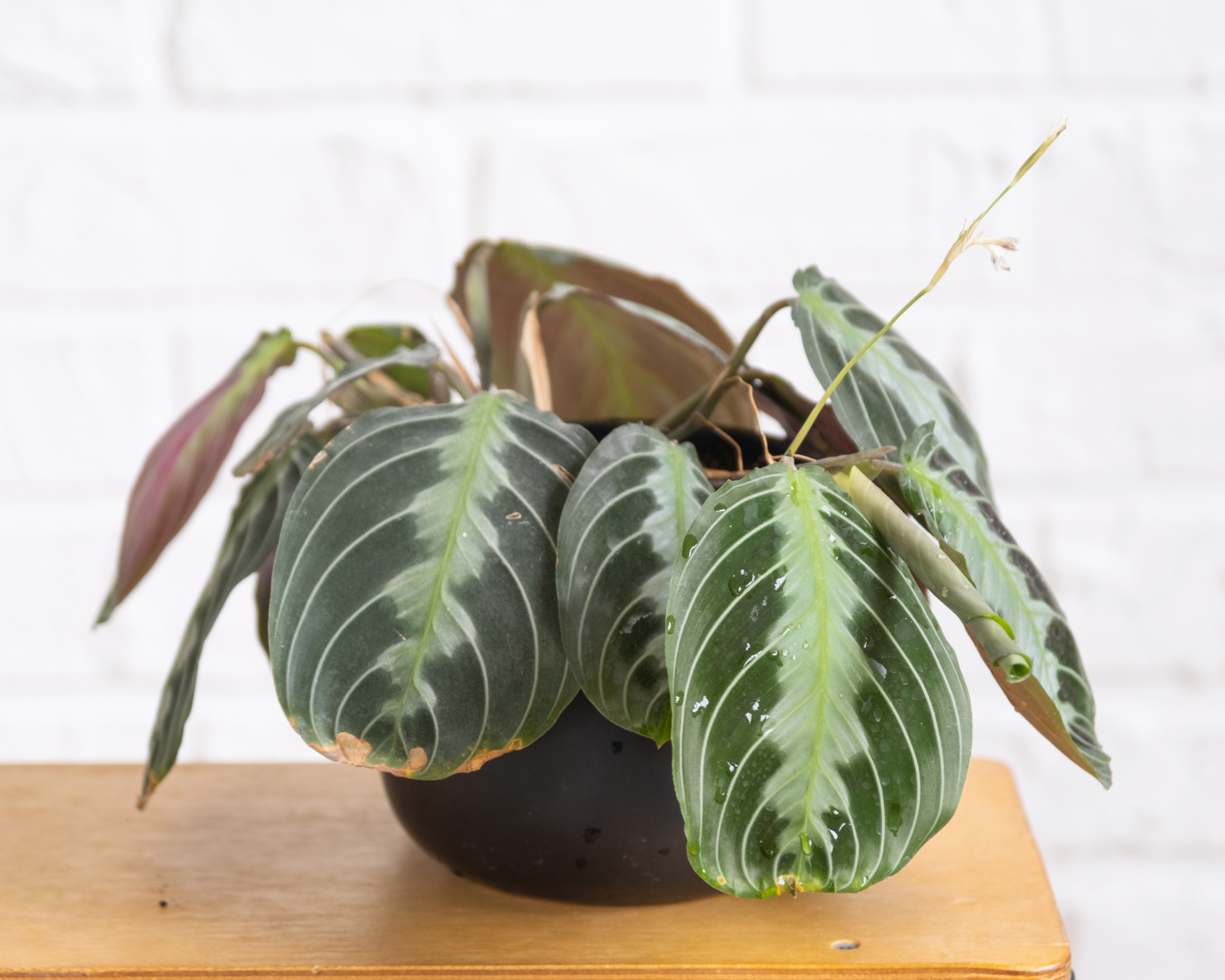The prayer plant (Maranta leuconeura) is an easy to grow and exotic-looking houseplant that makes a great addition to any indoor garden. While it is generally a hard-to-kill houseplant, it does have specific needs.
We'll dig into the basics of prayer plant care and look at exactly what growing conditions these plants need to survive and thrive, as well as how to plant and propagate them, and how to troubleshoot any potential problems.
What Is a Prayer Plant?
Quick Facts
Botanical name:
Maranta leuconeura
Height:
12-15 inches (30-38 cm)
Spread:
12-15 inches (30-38 cm)
Sun exposure:
Low light
Soil requirements:
Well-draining potting soil
Hardiness zones:
11-12
When to plant:
Spring
The prayer plant is a clump forming, low evergreen grown for its lovely foliage. This tropical perennial is native to the rainforests of Central and South America.
Prayer plant (Maranta leuconeura) grows to about 12-15 inches (30-38 cm) in height and width. Its elliptical to oval leaves are adorned with white or red veining, patterns, lines, shading and blotches. Even the underside of the foliage is decorative, ranging in color from gray/green to purple depending on the different prayer plant varieties.
In the late spring to early summer, the plant blooms with white, purple spotted double-lipped flowers borne off of slender spikes. These blooms are fairly insignificant and rarely make an appearance on houseplants. Though when grown in ideal conditions, plants will bloom.

Maranta’s common name is derived from the habit of the plant’s leaves. They close upward at nightfall resembling praying hands. The Venetian physician and botanist, Bartolomeo Maranti lends his surname as the "Maranta" genus. While "leuconeura" comes from the Greek leuko meaning white and neura meaning string; a reference to the plant’s white leaf veins.
Maranta vs. Calathea Prayer Plants
Don't confuse the Maranta prayer plant with its relative, the confusingly named Calathea prayer plant. There are several key differences that will help you identify Calathea vs. Maranta plants.
Sign up for the Gardening Know How newsletter today and receive a free copy of our e-book "How to Grow Delicious Tomatoes".
Since both plants have leaves with a somewhat painted appearance, the easiest way to tell them apart is to look at the plant's growth habit. Maranta is a vining plant and Calathea is shrubbier and grows upright. Calathea also often features more purple on its leaves, though this can change depending on variety.
Prayer Plant Care
As mentioned, prayer plant is a fairly low-maintenance plant, provided you can mimic its native environment. This means you must pay careful attention to humidity, temperature, and light.
Light
In its native region, the prayer plant thrives in a lower light setting. To copy their light needs inside, keep plants in partial shade, either in a shady window or protected from brighter light with a sheer curtain. However, beware of drafts by windows.
Soil
Prayer plants do best in a soil-based potting mix made for houseplants. These plants prefer well-drained soil and require high humidity to thrive. Prayer plant soil should be kept moist, but not soggy. During winter dormancy, the soil should be kept drier.
Water
Water prayer plants with tepid water to avoid shocking them. Keep soil moist during the growing period of March through September. In the winter, allow the top inch of soil to dry out before watering again. Avoid the use of hard water, if possible, as it will leave mineral deposits on the foliage or in the soil.
Temperature & Humidity
Prayer plants are intolerant of temperatures below 60 F (16 C) and will die if they experience frost. Ideal household temperatures for this plant are between 60 and 80 F (16-27 C).
Dry air can be a problem for houseplants in winter. To combat this, place your prayer plant amidst several other houseplants to help create more humid conditions.
You can also place a bowl of water near the plant or setting its container on top of a shallow dish of pebbles and water is also helpful. However, do not allow the prayer plant to sit directly in water.
Fertilizer
Fertilize plants with a standard, all-purpose liquid fertilizer for houseplants every two weeks during the growing season, from March through September. Don't fertilize plants during dormancy in the winter months.
Repotting & Pruning
Prayer plants do like to be somewhat root bound, so you only need to repot them every 1-2 years. Repot in early spring, at which time you can also propagate your prayer plant by division. Use fresh, well-draining houseplant potting mix when repotting.

Although prayer plants do not need to be pruned, trimming their vines just above a leaf node can create a bushier plant. You can also use these trimmings to propagate more prayer plants.
Propagation
Take stem cuttings from spring to early summer. Make cuts just below the nodes closest to the bottom of the stem. Then place cuttings in a mixture of moist peat and perlite and cover with plastic to retain moisture levels. You may want to poke a few air holes in the plastic to allow for adequate ventilation as well, then set cuttings in a sunny location.
If a piece of prayer plant has broken off, dip the broken end into rooting hormone and place it in distilled water. Change the water every other day. Wait until the roots are about an inch long before taking it out to place in soil. Keep in mind with prayer plant propagation that there needs to be a least a small portion of stem on the leaves in order for the piece to take root. Alternatively, the piece can be rooted directly in soil, as with cuttings.
Problems, Pests & Diseases
Prayer plants can be finicky about humidity and water. Crispy, brown leaves on a prayer plant or dropping leaves are often signs of these conditions being incorrect. Check them out first.
Prayer plants are also susceptible to several diseases. Cucumber mosaic virus results in distorted, yellowing foliage in a mosaic pattern. The only control is to destroy affected plants. In the future, aphids are a vector for this disease so aphid control is the key to CMV control.
Helminthosporium leaf spot is another disease that can afflict prayer plants. Signs of this disease are small water-soaked leaf spots. This fungal disease is caused by overhead watering. Treat it with a fungicide.
Root knot nematode stunts plants and galls roots. Infected plants should be thrown away.
Tip burn is caused by phosphate fertilizer or fluoride toxicity from high light. It causes brown leaf tips and margins that will eventually die. Ease up on water and fertilizer and avoid superphosphate or perlite, which contain fluoride.

Since prayer plants are also prone to pests like spider mites, mealybugs and aphids, it's a good idea to inspect new plants thoroughly before bringing them indoors. Occasionally check houseplants as an added precaution when watering or fertilizing for any problems.
Ultimately, though, learning how to grow a prayer plant is easy and the rewards are well worth any issues you may come across along the way.

Amy Grant has been gardening for 30 years and writing for 15. A professional chef and caterer, Amy's area of expertise is culinary gardening.
- Heather RhoadesFounder of Gardening Know How
- Laura WaltersContent Editor
